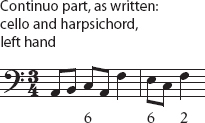The Continuo
Yet all this polyphony is supported by a solid scaffold of harmony. The central importance of harmony in Baroque music appears in the universal practice of the basso continuo, or just continuo.
The continuo is a bass part (the lowest part in polyphonic music) that is always linked to a series of chords. These chords are played by a harpsichord, organ, or lute as support or accompaniment for the important melodies in the other instruments. Indeed, we might say “mere accompaniment,” for composers did not bother to write the chords out in detail, but only notated them in an abstract way by a numerical shorthand below the bass part. (Another name for continuo, figured bass, derives from this numerical shorthand.)

This left continuo players with a good deal to do, even though their role was considered subsidiary. By reading the basso continuo part, the harpsichordist or organist would play along with the cellos or bassoons — this with the left hand, which doubles the bass line. But the right-

Continuo chords provide the basic harmonic framework against which the contrapuntal lines of Baroque music trace their airy patterns. This Baroque texture may be described as polarized — a polarity of voices between a strong bass and a clear, high (soprano) range, the domain of the melody. Less clearly defined is a middle space containing the improvised chords. In Baroque works on the largest scale, this space is also filled in by polyphonic lines drawn from the median range of the orchestra and chorus, such as violas, tenors, and altos. In more modest works a characteristic texture is a hollow one: one or two high instruments (violins, flutes) or voices, a bass instrument, and subsidiary chord improvisation in the middle.
Baroque music is usually easily identified by the presence of the continuo — by the continuous but discreet sound of the harpsichord or organ playing continuo chords in the background. Indeed, the Baroque era in music was once called the basso continuo era, not a bad name for it.
